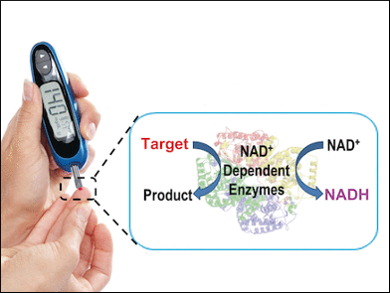Personal Glucose Meters for Biomarker Detection
Not only glucose: It is possible that people use their personal glucose meters for the quantification of other biomarkers than glucose in their blood, say American scientists from the University of Illinois. They explore a system based on the nicotinamide coenzymes that triggers linear responses in normal personal glucose meters. It allows the quantitative evaluation of lactate levels and other relevant biomarkers in blood samples, as described in the journal Angewandte Chemie.
The uncomplicated and convenient quantification of glucose levels by the diabetics themselves with personal glucose meters (PGMs) has become standard over the last decades, and most PGMs today use electrochemical methods. The working principle of that PGMs is the enzymatic oxidation of glucose, re-oxidation of the enzyme by a mediator, and further re-oxidation of the mediator at the electrode. The redox reactions of the mediator produce an electric current at the electrode, the amount of which is linearly related to the concentration of glucose.
Measuring Lactate Levels Using NADH
So, is it possible to use this well-established electrochemical detection system for the quantification of other biomarkers as well? Without major changes in its architecture or the chemicals used? This question is addressed by the group of Yi Lu at the University of Illinois, USA, by choosing a well-known and redox-active molecule, the nicotinamide coenzyme, such as the reduced form of nicotinamide adenine dinucleotide (NADH) to play the central role in repurposing the PGM for detecting other targets. NADH is used by a plethora of natural redox enzymes in biological systems and so this molecule could provide the link between the biological target molecule, for example, lactate, and the mediator on the PGM electrode.
Lactate levels are measured routinely in many clinical tests, for example, for people with diabetes, who also routinely measure their glucose levels. Simultaneous detection of glucose and lactate by point-of-care (POC) diagnosis would be very advantageous: “Such a one-step homogeneous assay holds great promise for POC detection at home,” the authors write. Having established a dose-dependent relationship between NADH concentration and PGM readout signal, the scientists also found a clear dependency of the PGM signal from the lactate concentrations: “A quantitative relationship is established between the PGM signal and L-lactate concentration,” they say.
Removing Glucose Interference
Essentially, the new assay system developed by Lu and colleagues is based on a solution with the relevant enzymes of the enzyme cascade for the reactions, which is then added to the sample of interest. After a certain reaction time, the PGM signal is recorded. But how can a glucose meter measure lactate and not glucose in the serum or plasma? The scientists used the most simple approach: “To remove the (glucose) interference, we employed another enzyme, hexokinase, which can catalyze the conversion of glucose to glucose-6-phosphate that is known to register no reading on the PGM.” In effect, their enzymatic cocktail employed for lactate measurements in patient plasma samples led to results that were very similar to the results of established methods.
With the new method, even simultaneous measurements of L-lactate and glucose in one PGM are within reach. “Our design allows simultaneous target detection and endogeneous glucose removal homogeneously in one single step,” the authors say. Other targets also relying on the NADH coenzyme response are envisaged as well.
- Dose-Dependent Response of Personal Glucose Meters to Nicotinamide Coenzymes: Applications to Point-of-Care Diagnostics of Many Non-Glucose Targets in a Single Step,
Jingjing Zhang, Yu Xiang, Miao Wang, Ananda Basu, Yi Lu,
Angew. Chem. Int. Ed. 2015.
DOI: 10.1002/anie.201507563




